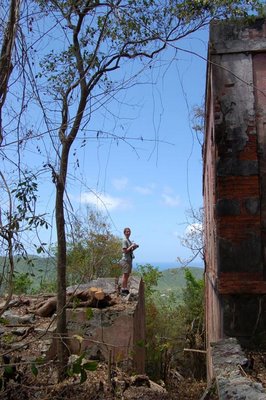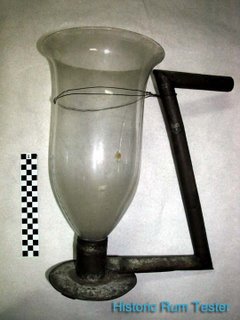
Since a good portion of the cultural resources of the Virgin Islands National Park are underwater, diving is an important part of our work. Both Ken and Susanna are on the dive team and participated in a dive recertification for the National Park most of the week. On Tuesday, the dive team traveled to St. Thomas to visit the hyperbaric chamber and attend lectures on hyperbaric medicine. The highlight of the day (besides docking next to mega cruise ships in the harbor) was a ride in the hyperbaric chamber down to 60”ft for about ten minutes. If the scenario was not hypothetical, and a diver was suffering from the bends, it would take at least 245 minutes at various depths to properly decompress the patient. The National Park Service is the oldest civilian diving organization in the government and because of the extensive safety protocol and rigorous training schedules, the park has never suffered a loss in a diving accident. Yesterday, the dive team completed a 2700m swim in less than 18 minutes and went through a serious of practices including “ditching” all the gear underwater and putting it back on, rescue breathing and map and compass work. This week fulfills part of the 24hr/year requirements for dive team members.
 In addition to all the diving, Ken met with a historic mason, Edwin Colon, from the San Juan National Historic Site to discuss the repair of the Lameshur Ruins. The Lameshur Plantation was originally four plantations laid out during the 1720’s. These estates were eventually consolidated into a single unit of production by 1740, producing mostly cotton. Between 1773 and 1784 some sugar cane was cultivated and the painting from this period shows that most of the acreage had been cleared. Sugar production was discontinued after 1858 and Lameshur transitioned into raising stock. The first US Coast and Geodetic Survey shows that in 1919, most of the land was planted in either fruit, bay trees or grass pasture for the large herd of cattle. Cattle farming and bay leaf harvesting ceased in the early 1950’s and most of the plantation buildings have fallen into various stages of ruin. Interestingly, the presence of lime trees on the grounds shed light on the name “Lameshur.” According the small booklet, “Some True Tales and Legends about Caneel Bay and Trunk Bay, and a hundred and on other places on St. John,” compiled by Charlotte Dean Stark in 1960, The Geographic Dictionary says the name signifies Lemon Shore or Lime Shore. Map makers of the old days, who seem to have found the name incredible, changed it to La Masure, French for “The ruin.” Through this series of mistaken pronunciations and etymologies, it became Lameshur on the US map of 1934.
In addition to all the diving, Ken met with a historic mason, Edwin Colon, from the San Juan National Historic Site to discuss the repair of the Lameshur Ruins. The Lameshur Plantation was originally four plantations laid out during the 1720’s. These estates were eventually consolidated into a single unit of production by 1740, producing mostly cotton. Between 1773 and 1784 some sugar cane was cultivated and the painting from this period shows that most of the acreage had been cleared. Sugar production was discontinued after 1858 and Lameshur transitioned into raising stock. The first US Coast and Geodetic Survey shows that in 1919, most of the land was planted in either fruit, bay trees or grass pasture for the large herd of cattle. Cattle farming and bay leaf harvesting ceased in the early 1950’s and most of the plantation buildings have fallen into various stages of ruin. Interestingly, the presence of lime trees on the grounds shed light on the name “Lameshur.” According the small booklet, “Some True Tales and Legends about Caneel Bay and Trunk Bay, and a hundred and on other places on St. John,” compiled by Charlotte Dean Stark in 1960, The Geographic Dictionary says the name signifies Lemon Shore or Lime Shore. Map makers of the old days, who seem to have found the name incredible, changed it to La Masure, French for “The ruin.” Through this series of mistaken pronunciations and etymologies, it became Lameshur on the US map of 1934. Other than that, Mick is off island for a couple of weeks of vacation, Molly is busy photographing the collection such as this ceremonial celt, and a new intern, Katie, from the University of the Virgin Islands just signed on to help us out a couple of days a week. After such a busy week everyone is looking forward to the three day holiday weekend and participating in the Friends of the Virgin Islands National Park Beach-to-Beach PowerSwim. http://www.friendsvinp.org/swim/06info.htm. Good luck to all the swimmers!
Other than that, Mick is off island for a couple of weeks of vacation, Molly is busy photographing the collection such as this ceremonial celt, and a new intern, Katie, from the University of the Virgin Islands just signed on to help us out a couple of days a week. After such a busy week everyone is looking forward to the three day holiday weekend and participating in the Friends of the Virgin Islands National Park Beach-to-Beach PowerSwim. http://www.friendsvinp.org/swim/06info.htm. Good luck to all the swimmers!















